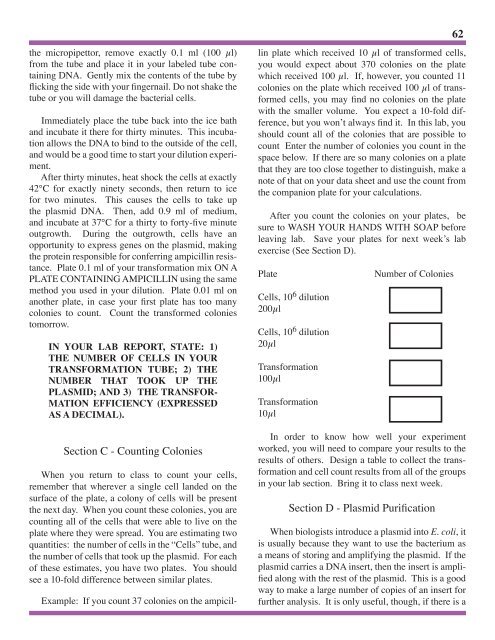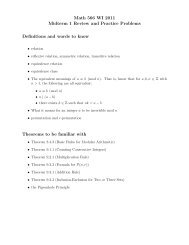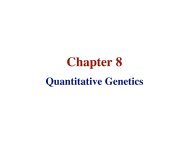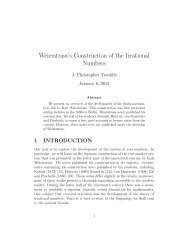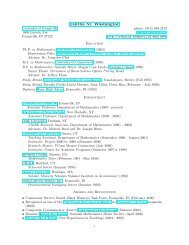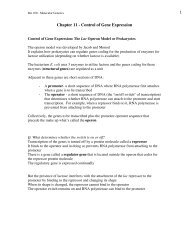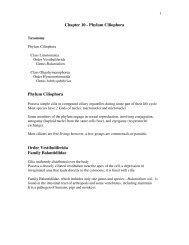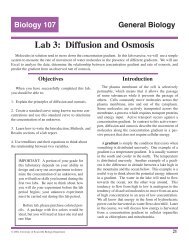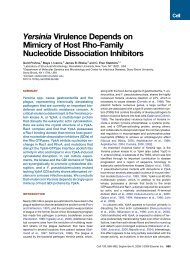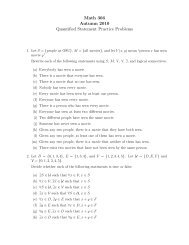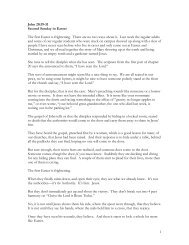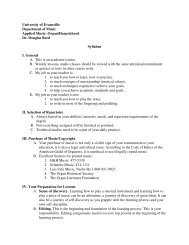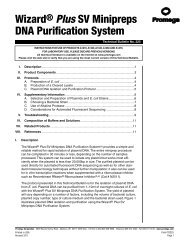If they are allowed to warm even slightly, your experimentwill not work.Since your tube contains hundreds <strong>of</strong> millions <strong>of</strong>cells, counting each <strong>and</strong> every one is not really possible.Instead, we will dilute the cells a known amount,count the cells in the diluted sample, <strong>and</strong> calculatethe number <strong>of</strong> cells in the original tube. The dilutioncalculations in the following example should becarefully reviewed before lab. If you want additionalexamples <strong>of</strong> dilution calculations, review your workfrom the first lab exercise.DILUTION SAMPLE CALCULATIONAssume that a tube has 1 ml <strong>of</strong> mediumcontaining <strong>10</strong> 8 cells per ml. If you spreadall these cells on a plate, they would beimpossible to count. Since we can onlyreally count about <strong>10</strong>0 (<strong>10</strong> 2 ) cells on eachplate, we must dilute the cells in the originaltube one million (<strong>10</strong> 6 ) fold (<strong>10</strong> 8 cells inthe original tube divided by <strong>10</strong> 6 = <strong>10</strong> 2 cellson the plate) so that we can count them.Plating <strong>and</strong> counting the cells in a <strong>10</strong> 6 folddilution <strong>of</strong> our original cells will allow usto multiply by one million to get back tothe number <strong>of</strong> cells per ml we started with.(<strong>10</strong>0 cells on the plate multiplied by <strong>10</strong> 6 =<strong>10</strong> 8 cells in the original tube)A one-million-fold dilution is impossible to carryout in a single step without using large quantities <strong>of</strong>liquid. For example, diluting your original 0.1 ml onemillion fold in one step would require 99,999.9 mlor approximately <strong>10</strong>0 liters <strong>of</strong> medium. Instead, wewill use serial dilutions. Before beginning your dilution,you should watch the instructor demonstrate theuse <strong>of</strong> the micropipettors. Using these devices is animportant skill in the biology laboratory, <strong>and</strong> yourgrade depends on careful measurement.At the worktable, select three sterile microtubesfor each group <strong>and</strong> label them <strong>10</strong> -2 , <strong>10</strong>-4, <strong>and</strong> <strong>10</strong> -6 .Working sterilely, use the micropipettor to place 0.99ml (990 µl) <strong>of</strong> sterile medium into each <strong>of</strong> the threesterile tubes. Remember that any bacteria introducedfrom your h<strong>and</strong>s or elsewhere will throw <strong>of</strong>f yourcount. Then, place <strong>10</strong> µl <strong>of</strong> your bacterial sample intoyour tube marked <strong>10</strong> -2 . Note that this is a <strong>10</strong>0 (<strong>10</strong> 2 )fold dilution <strong>of</strong> your original tube. Mix this tube well.Then, using a new sterile tip (why?) take <strong>10</strong> µl fromthis tube <strong>and</strong> place it in the tube marked <strong>10</strong> -4 , for a <strong>10</strong> 4dilution. Mix, <strong>and</strong> place <strong>10</strong> µl from this tube into thetube marked <strong>10</strong> -6 for a <strong>10</strong> 6 dilution.Now, still working sterilely, spread 200 µl <strong>of</strong> your<strong>10</strong> -6 dilution onto an agar plate using the hockeystickmethod demonstrated by your instructor. Sinceyou want to assure that you can count the cells on theplate, make another counting plate with 20 µl <strong>of</strong> your<strong>10</strong> -6 dilution.For your protocol, make a diagram explainingyour dilutions. Draw the tubes <strong>and</strong> plates you willuse, the amounts <strong>of</strong> liquid in each transfer, <strong>and</strong> howmany cells you expect in each tube or on each plate ifyour original solution has <strong>10</strong> 9 cells per ml.Make sure the plates are properly labeled, <strong>and</strong>give them to your instructor for overnight incubation.Arrange for your lab group to visit the lab tomorrowto count the bacterial colonies on the plate, <strong>and</strong> if necessaryto redo the experiment.Before you leave class, use your dilution diagramto think about how you will answer the followingquestion: what was the number <strong>of</strong> cells per ml in theoriginal tube? For example, if you count 17 cells in<strong>10</strong>0 μl <strong>of</strong> your <strong>10</strong> -6 dilution, how many cells are ineach ml <strong>of</strong> this dilution? How many cells are in eachml <strong>of</strong> the <strong>10</strong> -4 dilution? How many cells per ml in theoriginal tube?IN YOUR LAB REPORT, STATE THENUMBER OF CELLS PER ml IN THEORIGINAL TUBE.Section B - Transformation61DNA has been prepared for you by your instructor<strong>and</strong> 1 µl <strong>of</strong> DNA solution will be placed into asterile 1.5 ml tube for each group. (One µl is 0.001ml <strong>and</strong> pronounced microliter. It is also referred to asλ or lambda.) Label the tube with your group number<strong>and</strong> get ready to place 0.1 ml (<strong>10</strong>0 µl) <strong>of</strong> cells fromthe ice water bath into the tube. It is essential that thecells stay ice cold <strong>and</strong> sterile at all times. Quicklyremove the tube labeled “Cells” from the ice bath,invert gently to mix, carefully open the cap <strong>and</strong>, using
the micropipettor, remove exactly 0.1 ml (<strong>10</strong>0 µl)from the tube <strong>and</strong> place it in your labeled tube containingDNA. Gently mix the contents <strong>of</strong> the tube byflicking the side with your fingernail. Do not shake thetube or you will damage the bacterial cells.Immediately place the tube back into the ice bath<strong>and</strong> incubate it there for thirty minutes. This incubationallows the DNA to bind to the outside <strong>of</strong> the cell,<strong>and</strong> would be a good time to start your dilution experiment.After thirty minutes, heat shock the cells at exactly42°C for exactly ninety seconds, then return to icefor two minutes. This causes the cells to take upthe plasmid DNA. Then, add 0.9 ml <strong>of</strong> medium,<strong>and</strong> incubate at 37°C for a thirty to forty-five minuteoutgrowth. During the outgrowth, cells have anopportunity to express genes on the plasmid, makingthe protein responsible for conferring ampicillin resistance.Plate 0.1 ml <strong>of</strong> your transformation mix ON APLATE CONTAINING AMPICILLIN using the samemethod you used in your dilution. Plate 0.01 ml onanother plate, in case your first plate has too manycolonies to count. Count the transformed coloniestomorrow.IN YOUR LAB REPORT, STATE: 1)THE NUMBER OF CELLS IN YOURTRANSFORMATION TUBE; 2) THENUMBER THAT TOOK UP THEPLASMID; AND 3) THE TRANSFOR-MATION EFFICIENCY (EXPRESSEDAS A DECIMAL).Section C - Counting ColoniesWhen you return to class to count your cells,remember that wherever a single cell l<strong>and</strong>ed on thesurface <strong>of</strong> the plate, a colony <strong>of</strong> cells will be presentthe next day. When you count these colonies, you arecounting all <strong>of</strong> the cells that were able to live on theplate where they were spread. You are estimating twoquantities: the number <strong>of</strong> cells in the “Cells” tube, <strong>and</strong>the number <strong>of</strong> cells that took up the plasmid. For each<strong>of</strong> these estimates, you have two plates. You shouldsee a <strong>10</strong>-fold difference between similar plates.Example: If you count 37 colonies on the ampicillinplate which received <strong>10</strong> µl <strong>of</strong> transformed cells,you would expect about 370 colonies on the platewhich received <strong>10</strong>0 µl. If, however, you counted <strong>11</strong>colonies on the plate which received <strong>10</strong>0 µl <strong>of</strong> transformedcells, you may find no colonies on the platewith the smaller volume. You expect a <strong>10</strong>-fold difference,but you won’t always find it. In this lab, youshould count all <strong>of</strong> the colonies that are possible tocount Enter the number <strong>of</strong> colonies you count in thespace below. If there are so many colonies on a platethat they are too close together to distinguish, make anote <strong>of</strong> that on your data sheet <strong>and</strong> use the count fromthe companion plate for your calculations.After you count the colonies on your plates, besure to WASH YOUR HANDS WITH SOAP beforeleaving lab. Save your plates for next week’s labexercise (See Section D).PlateCells, <strong>10</strong> 6 dilution200µlCells, <strong>10</strong> 6 dilution20µlTransformation<strong>10</strong>0µlTransformation<strong>10</strong>µlNumber <strong>of</strong> ColoniesIn order to know how well your experimentworked, you will need to compare your results to theresults <strong>of</strong> others. Design a table to collect the transformation<strong>and</strong> cell count results from all <strong>of</strong> the groupsin your lab section. Bring it to class next week.Section D - Plasmid Purification62When biologists introduce a plasmid into E. coli, itis usually because they want to use the bacterium asa means <strong>of</strong> storing <strong>and</strong> amplifying the plasmid. If theplasmid carries a DNA insert, then the insert is amplifiedalong with the rest <strong>of</strong> the plasmid. This is a goodway to make a large number <strong>of</strong> copies <strong>of</strong> an insert forfurther analysis. It is only useful, though, if there is a


